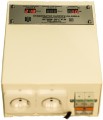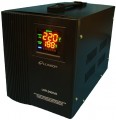Power
The maximum active load power allowed for this model.
Active power is the power that in AC appliances is spent on useful work or on heat generation. In addition to it, such devices also consume reactive power — it goes to the operation of specific components, primarily capacitors and inductors. Apparent power, denoted in volt-amperes (kilovolt-amperes), is the sum of active and reactive, see below about it. Here we note that in simple everyday situations, there is enough data on active power indicated in watts for calculations. In particular, it is this parameter that is considered the key when choosing stabilizers
for washing machines and
dishwashers : in the first case, power from 2 to 5 kW is considered optimal, in the second — from 1.8 to 2.5 kW.
Anyway, the total active power of the connected load should not exceed the figures indicated in the characteristics of the stabilizer. For a full guarantee, it's ok to take a certain margin, but this margin should not be too large — an increase in the allowable power significantly affects the dimensions, weight and price of the device. Also note that there are formulas that allow you to convert the active power consumption into total power, taking into account the type of connected electrical appliance; these formulas can be found in special sources.
Power
Maximum apparent load power allowed for this model
In electrical engineering, full power is called, which takes into account both active and reactive power; the first type of power is discussed above, and the second can be described as the effect of windings, inductors and capacitors on the operation of AC networks. Apparent power is the main parameter for calculating loads on equipment in professional electrical engineering; it is usually denoted in volt-amperes (VA), in the case of stabilizers — in kilovolt-amperes (kVA). Note that for convenience, different types of power in electrical engineering are denoted by units with different names. That is why the power in W indicated in the characteristics of the stabilizer is usually not equal to its power in VA.
When choosing a stabilizer for some household appliances, it is quite enough to have active power data, but if possible it is better to use the full one. In particular, it is this parameter that is key when looking for
a stabilizer for a refrigerator or
a stabilizer for a boiler : in the first case, 0.4 – 1 kVA is considered the optimal value, in the second — from 0.1 to 0.7 kVA. However, anyway, it is necessary to choose a specific model in such a way that its total power is not lower than the total power of the entire connected load — and it is better to have a reserve (in case of unforeseen circumstances or connecting additional eq
...uipment). At the same time, note that powerful models are distinguished by large dimensions and weight, and most importantly, high cost; therefore, it does not always make sense to chase the maximum numbers.
Also note that there are formulas that allow you to derive the optimal total power of the stabilizer based on data on active power and type of load; they can be found in special sources.Input voltage range
The voltage range at the input of the stabilizer, at which it is able to operate in normal mode and supply a constant voltage of 230 or 400 V to the load (depending on the number of phases, see above). The wider this range — the more versatile the device, the more serious power surges it can extinguish without going beyond the standard operating parameters. However, note that this parameter is not the only, and not even far from the main indicator of the quality of work: a lot also depends on the accuracy of the output voltage and the response speed (see both points below).
Also note that some models may have several modes of operation (for example, with 230 V, 230 V or 240 V output). In this case, the characteristics indicate the "general" input voltage range, from the smallest minimum to the largest maximum; the actual ranges for each particular mode will vary.
In addition, there are stabilizers that can operate outside the nominal input voltage range: with a slight deviation beyond its limits, the device provides relatively safe output indicators (also with some deviations from the nominal 230 or 400 V), but if the drop or rise becomes critical, it works appropriate protection (see below).
Output voltage accuracy (±)
The largest deviation from the nominal output voltage (230 V or 400 V, depending on the number of phases), which the regulator allows when operating in the normal input voltage range (see above). The smaller this deviation, the more efficiently the device works, the more accurately it adapts to “changes in the situation” and the less voltage fluctuations the connected load is exposed to.
When choosing for this parameter, it is worth considering first of all how demanding the connected devices are for voltage stability. On the one hand, high stability is good for any device, on the other hand, it usually means a high price. Accordingly, it usually does not make sense to buy an advanced stabilizer for an unpretentious load like light bulbs and heaters, but for sensitive devices like audio systems or computers, it can be very useful.
Response time
The rate at which the regulator responds to changes in input voltage. It is determined by the time that passes from the moment of a power surge until the moment when the device fully adjusts to the new parameters and the output current corresponds to the standard 230 or 400 V (depending on the number of phases, see above). Accordingly, the shorter the response time, the better the stabilizer works, the lower the likelihood that a power surge will significantly affect the connected equipment. On the other hand, not all types of electrical appliances are sensitive to speed — for some, smooth adjustment or voltage accuracy is more important (see above); and the high speed itself can significantly affect the price of the device. Therefore, when choosing by this parameter, it makes sense to consider which devices are planned to be connected through the stabilizer.
IP protection rating
The degree of protection of the internal components of the stabilizer from various undesirable influences from the outside — first of all, from the ingress of moisture and foreign objects. The IP (ingress protection) standard is used to describe the protection provided by an enclosure.
In marking according to this standard, two digits are usually used — for example, IP54. The first digit describes the degree of protection against various solid objects (up to and including sand and dust). Its specific meanings may be as follows:
1 — protection against objects measuring 50 mm or more (for comparison: the average male fist will no longer pass even through the largest hole in such a case).
2 — from objects with a size of 12.5 mm or more (comparable to the thickness of a finger on a hand).
3 — from objects with a size of 2.5 mm or more (we can talk about protection against accidental contact with most standard tools).
4 — from objects with a size of 1 mm or more (for example, most wires).
5 — medium degree of protection against dust (it is allowed to get inside a certain amount of dust that does not affect the operation of the device).
6 — the maximum degree of protection against dust (its ingress is practically excluded).
The second digit, respectively, describes the resistance to moisture:
1 — minimum degree of protection — the device, placed in the working position, is resistant to individual drops falling vertica...lly on it.
2 — vertical drops are allowed when the device deviates from the working position by less than 15 °.
3 — splashes flying at an angle of up to 60 ° from the vertical are allowed; rain protection.
4 — resistance to splashes from any direction; wind and rain protection.
5 — resistance to water jets; protection from heavy rains, storms.
6 — short-term ingress of large volumes of water is allowed — for example, when a wave hits.
7 — the possibility of short-term immersion under water to a shallow depth (up to 1 m).
8 — the ability to work at a depth of 1 m and for a longer time.
One of the numbers can be replaced by the letter X — this usually means that the device does not have official certification in the corresponding direction of protection. In some cases, this suggests that there is no such protection at all — for example, the IP2X case is most likely not designed for any water ingress at all. However, it can be the other way around — for example, IPX7: a housing with the ability to submerge under water will certainly be well protected from dust, even if this is not officially announced.
Of course, it is worth choosing an option for this parameter, first of all, taking into account the expected operating conditions: for example, for a dry utility room, water protection is useless (it will only cost extra money), but in a damp basement, such a case can be very out of place. However, note that no protection provides absolute guarantees and does not eliminate the need to comply with safety rules.
Carrying handle
The presence in the design of the stabilizer of a special
handle for carrying the device from place to place. This feature is useful primarily for powerful and, accordingly, heavy devices, which would be inconvenient to hold directly by the case. And in the most "weighty" models, which are not designed to be carried alone, there are several handles.

